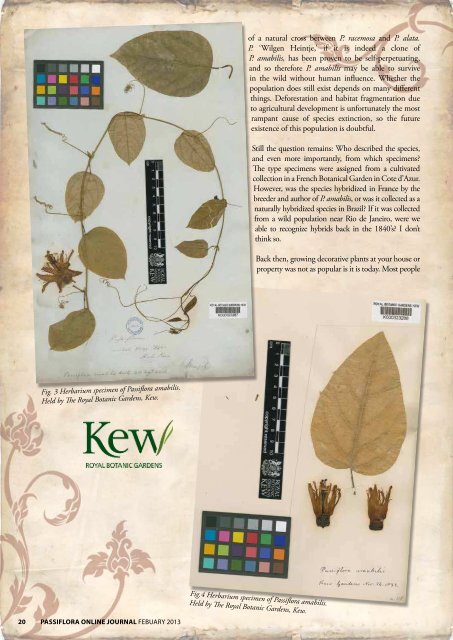Issue 3 2013 Lo-res PDF - Passion Flowers
Issue 3 2013 Lo-res PDF - Passion Flowers
Issue 3 2013 Lo-res PDF - Passion Flowers
Create successful ePaper yourself
Turn your PDF publications into a flip-book with our unique Google optimized e-Paper software.
of a natural cross between P. racemosa and P. alata.<br />
P. ‘Wilgen Heintje,’ if it is indeed a clone of<br />
P. amabilis, has been proven to be self-perpetuating,<br />
and so therefore P. amabilis may be able to survive<br />
in the wild without human influence. Whether the<br />
population does still exist depends on many different<br />
things. Defo<strong>res</strong>tation and habitat fragmentation due<br />
to agricultural development is unfortunately the most<br />
rampant cause of species extinction, so the future<br />
existence of this population is doubtful.<br />
Passiflora Online Journal February <strong>2013</strong><br />
21<br />
Still the question remains: Who described the species,<br />
and even more importantly, from which specimens?<br />
The type specimens were assigned from a cultivated<br />
collection in a French Botanical Garden in Cote d’Azur.<br />
However, was the species hybridized in France by the<br />
breeder and author of P. amabilis, or was it collected as a<br />
naturally hybridized species in Brazil? If it was collected<br />
from a wild population near Rio de Janeiro, were we<br />
able to recognize hybrids back in the 1840’s? I don’t<br />
think so.<br />
Back then, growing decorative plants at your house or<br />
property was not as popular is it is today. Most people<br />
Fig. 2 Passiflora amabilis<br />
© 2011 Yero Kuethe<br />
Fig. 3 Herbarium specimen of Passiflora amabilis.<br />
Held by The Royal Botanic Gardens, Kew.<br />
in Brazil collected their needs from the nearby fo<strong>res</strong>ts, perhaps<br />
only growing crops of commercial value, like P. alata for their<br />
fruit or as herbs. P. racemosa is not commercially valued for<br />
its fruit, but for its decorative flowers and may have been<br />
cultivated by enthusiasts who admired the unique racemes<br />
back in the 1840’s. The chances that the two species actually<br />
hybridized in that time are slim, but possible. More detailed<br />
and professional observation of the natural population is<br />
necessary to confirm this theory. Till then, we will struggle to<br />
establish the facts from the options that are:<br />
1- The species is being described from cultivated specimens,<br />
(most likely from France).<br />
2- The species has been reported from a wild population.<br />
3- The species is definitely a hybrid between P. racemosa and P. alata.<br />
4- The species was recognized as a hybrid before it was described.<br />
The Passiflora Project International is intent on solving this<br />
mystery by organising an expedition to these two parks, and<br />
attempting to relocate this population found in 1953.<br />
REFERENCES<br />
Harms, R.C. 1893: Naturlichen Pflanzenfamilien.<br />
Monograph<br />
Masters, 1872: Flora Brasiliensis.<br />
Monograph<br />
Killip, E.P. 1938: The American species of Passifloraceae.<br />
Monograph<br />
Killip, E.P. 1960: Supplemental notes on American Passiflora<br />
Contributors of Royal Herbarium and Botanical Gardens.<br />
Kuethe, Y.R. 2011: PPI Official list of recognized Passiflora<br />
Database of species determination.<br />
Kuethe, Y.R. 2011: PPI Monograph on Passiflora genus.<br />
Monograph<br />
Lemaire, 1847: Flore des Ser<strong>res</strong> et des Jardins de l’Europe<br />
Contributors of Botanical Heritage Magazine.<br />
Coming soon:<br />
The continuation of the magnificent work of Elsworth Killip<br />
PPI Monograph on the Passiflora genus<br />
Fig.4 Herbarium specimen of Passiflora amabilis.<br />
Held by The Royal Botanic Gardens, Kew.<br />
PPI, Passiflora Project Int’l<br />
Yero R. Kuethe, Townsville 4810 QLD<br />
Australia.<br />
Kuethe@ppi.nu Tel: (+61) 042 6996 207<br />
20 Passiflora Online Journal Febuary <strong>2013</strong>
















